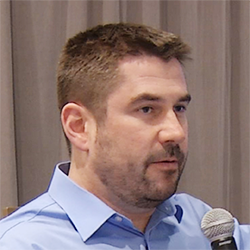Home » Dysautonomias » Overview of Autonomic Failure with David Goldstein, MD, PhD
Overview of Autonomic Failure with David Goldstein, MD, PhD
This video provides an overview of autonomic failure including discussion about Pure Autonomic Failure (PAF), Multiple System Atrophy (MSA), Lewy bodies (and other alpha-synucleinopathies) and other neurodegenerative diseases.
Mr. Al Ruechel: Hi everybody, I’m Al Ruechel and welcome as we continue our conversations about dysautonomia. Right now, we’re talking to Doctor David Goldstein. Doctor thank you so much for joining us. We’re going to be talking about the history of autonomic failure among other things. So, give me a little of your background and how long you’ve been involved in all of this.
Dr. David Goldstein: Well I’ve been doing research, clinical research, on how the brain regulates the cardiovascular system dating back to college days. So that’s basically most of my life, more than fifty years doing some sort of research related to the brain and the heart and the intervening system that mediates effects of the brain on the heart is the autonomic nervous system.
Mr. Ruechel: So, 1997 that’s a significant year what’s significant about that year?
Dr. Goldstein: 1997 there were three major discoveries that I think changed the field of autonomic research. First, in 1997 it was discovered that a rare Greek-Italian-American kindred where Parkinson’s was transmitted as an autosomal dominant gene trait, that means half the family had Parkinson’s. The genetic, specific genetic, cause was identified and this was a mutation, a mutation is like a typo in the genetic encyclopedia. And the mutation was for a protein called alpha-synuclein – nobody knows what alpha-synuclein does to this day. Somehow the mutation of alpha-synuclein was found to be the first identified cause of familial Parkinson’s disease. Now you could say this a very rare situation, Parkinson’s is most of the time sporadic there isn’t any identified genetic cause. But in 1997 another key discovery was that alpha-synuclein deposits occur inside nerve cells and these deposits are called Lewy bodies, although the guy was actually a German researcher his name was Levy, it’s a whole story. But Lewy bodies are a pathologic hallmark of Parkinson’s just sporadic Parkinson’s so when it was found there was alpha-synuclein depositions in Lewy bodies, this meant that alpha-synuclein had something to do with Parkinson’s disease overall. So far, I haven’t said anything about the autonomic nervous system.
Mr. Ruechel: It’s alright we’re getting there.
Dr. Goldstein: But, a third discovery in 1997 was by our group, we found that in Parkinson’s disease as well as another classic form of autonomic failure called pure autonomic failure, that there’s a substantial loss of nerves, autonomic nerves, in the heart in the movement disorder Parkinson’s disease. This was a complete surprise until then it was thought that the Parkinson’s was basically a movement problem, it’s a brain disease. But this discovery meant that Parkinson’s is a more generalized disease, it’s not just a brain disease and it involves a loss of particular nerves called sympathetic nerves in the heart. That meant that Parkinson’s was and is a dysautonomia. So, those are the three the discoveries that I think changed views of what causes Parkinson’s and the fact that the lesion, the problem, involves more than the brain, but involves the heart.
Mr. Ruechel: Now, when you talked about pure autonomic failure, does that have anything to do with chemical deficiencies in the body?
Dr. Goldstein: Yes, pure autonomic failure had other names before then but it’s characterized by orthostatic hypotension, orthostatic hypotension is a fall in blood pressure every time, every time the patient stands up. And the orthostatic hypotension is due to a biochemical problem. The biochemical problem is that for whatever reason the chemical messenger of the sympathetic nervous system, which is called norepinephrine or noradrenaline, is not reaching its receptors or the receptors are blocked. In the case of pure autonomic failure, it’s not reaching its receptors because it’s not being released, it’s not being released because the nerves that contain norepinephrine aren’t there anymore or they don’t store the norepinephrine, they don’t package it in a way that it can be released. So, pure autonomic failure, people have definitional issues here, but in my book PAF by definition involves a loss of stores of the chemical norepinephrine.
Mr. Ruechel: And all of this is tied up in the autonomic nervous system as well, I mean. Now, from what you’ve learned about Parkinson’s how does that translate into what you know about the autonomic nervous system in terms of what may cause it or what may trigger it?
Dr. Goldstein: Good question, I mentioned the Lewy bodies and that’s a pathologic hallmark of Parkinson’s, there are also biochemical hallmarks, what causes the movement disorder in Parkinson’s is known it’s been known for a half century and that is loss of a particular chemical called dopamine in a particular brain pathway, that’s what causes the movement disorder. Well, dopamine and norepinephrine are like father and son in a small chemical family called catecholamines. There are only three catecholamines in the body, dopamine, norepinephrine, and adrenaline which is the most famous catecholamine, that’s it. So, the concept is that there’s something, something relates catecholamine neurons, which are rare in the nervous system, and Lewy bodies why is that an association? And our theory, which we’ve been pursuing for several years, is that alpha-synuclein that protein that’s deposited in the catecholamine neurons interacts with products of oxidation of dopamine or norepinephrine and it’s that interaction that destroys the nerves, that’s the idea.
Mr. Ruechel: Does the PAF we talked about that, does it ever evolve into what we call multiple system atrophy, are they related?
Dr. Goldstein: That’s a controversial question.
Mr. Ruechel: Ok, it’s controversial, your opinion.
Dr. Goldstein: I don’t think there’s much doubt that PAF can evolve into Parkinson’s disease with orthostatic hypotension. About forty percent of people with Parkinson’s have orthostatic hypotension and one way Parkinson’s with orthostatic hypotension can occur is an evolution from PAF. Multiple system atrophy also involves alpha-synuclein deposits but the characteristic is not alpha-synuclein deposits in nerves instead it’s alpha-synuclein deposits in glial cells, these are like helper cells in the brain, they’re not neurons but they’re very important and the alpha-synuclein deposits are in the glial cells. Outside the brain most patients with multiple system atrophy have nothing wrong. And so, when you look for norepinephrine deficiency by scanning techniques for instance that I developed, there’s nothing wrong. So, there is a drastic difference between PAF or Parkinson’s with orthostatic hypotension or dementia with Lewy bodies, which is another thing that PAF can evolve into and MSA. If you don’t take into account the loss of norepinephrine, especially in the heart, if you don’t consider that, then it’s possible that PAF, what you think is PAF, can evolve into MSA.
Mr. Ruechel: We’ve been having a bit of a debate about all the terms used to describe the same condition an abnormal drop in blood pressure upon standing with symptoms of syncope or presyncope. Of all the terms that are out there what term would you use to describe that?
Dr. Goldstein: A new one, because what’s out there pretty much always includes a presumption about mechanism. So, when you say vasovagal syncope, vaso means blood vessels, vagal means a particular part of the nerve of the autonomic nervous system, and vasovagal syncope implies there’s something wrong with Vagus nerve or blood vessels or something like that. Neurocardiogenic syncope is another term that also implies there’s something in the nervous system, the nervous supply to the heart, that’s causing loss of consciousness. Neurally mediated hypotension is another one, neurally mediated implies that nerves are responsible for the fall in blood pressure, there are other terms as well. They all contain an inherent presumption about mechanism. So, I wanted to come up with something that doesn’t, just simply a description of the phenomenon. When people are worked up for syncope or frequent fainting, orthostatic intolerance, meaning they just can’t tolerate standing up a long time. They often undergo a tilt table test and one of the purposes of the tilt table test is to see if you could provoke the same phenomenon that the patients are complaining about and so we look for at some point during the tilting a sudden fall in pressure and we know when that happens, yeah that’s going to cause a loss of consciousness pretty quick. Well, that’s tilt evoked hypotension, no one is going to argue about that. So, I’ve started to refer to this phenomenon during tilt table testing as tilt evoked hypotension.
Mr. Ruechel: Now is it possible that of the things we’ve been talking about could actually be secondary causes of autonomic failure? Such as what we’re talking about diabetes, alcoholism, Guillain-Barre Syndrome, all of those kinds of things. Is that possible?
Dr. Goldstein: Well by definition a secondary cause means you know the person has a disease that’s already been established to be associated with chronic autonomic failure. A classic example is diabetes, there’s very substantial literature that at least a sub group of diabetic patients have something called diabetic autonomic neuropathy which can include orthostatic hypotension, usually includes other stuff. So, when you’re trying to work up a patient who has orthostatic hypotension you don’t come up with a diagnosis like pure autonomic failure, before you exclude other secondary causes of orthostatic hypotension, I think that’s what it’s about.
Mr. Ruechel: And just very quickly one line that you would say for physicians watching this right now. What’s your word of advice to them?
Dr. Goldstein: Read my book, I wrote a book called, as a part of my official job duties I work for the government so it’s free, just go to my website and download it, it’s called Principles of Autonomic Medicine.
Mr. Ruechel: And lastly for patients what would you want them to know?
Dr. Goldstein: Same book, that’s what’s special, maybe unique, about this book I put it together to be a shared resource for clinicians, for students, and for patients. You could say well how could you do that it would be totally different competencies, totally different educations, totally different expectations, I did it by kind of galumphing together two other books. One, a handbook for patients with dysautonomias and another a textbook, an academic textbook on the autonomic nervous system.
Mr. Ruechel: Well I’ll tell you what we’ll do we are putting links to those on this website as well. Thank you for all of your information. It’s nice to know somebody is delving into their entire life on a topic this specific, doctor thank you so much.
Dr. Goldstein: Sure.

Wolfgang Singer, MD
Associate Professor of Neurology
Mayo Clinic Rochester, MN































